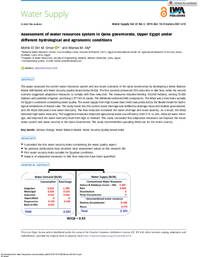Assessment of water resources system in Qena governorate, Upper Egypt under different hydrological and agronomic conditions

Authors:
This paper assessed the current water resources system and two future scenarios in the Qena Governorate by developing a Water Balance Model (WB Model) and Water Security Quality-based Index (WSQI). The first scenario presented 25% reduction in Nile flow, while the second scenario suggested adaptation measures to comply with flow reduction. The measures included leveling 100,000 feddans, serving 70,000 feddans with sprinkler irrigation, and lining 2,977 km of canals. The WB Model estimated WB components. The WSQI was a new index suitable for Egypt's conditions considering water quality. The water supply from High Aswan Dam (HAD) was predicted by the BlueM model for hydrological simulations of Nasser Lake. The study found that the current water shortage was fulfilled by drainage reuse and shallow groundwater, and the WQSI indicated a low water insecurity. The flow reduction increased the water shortage and reuse quantity. As a result, the WSQI indicated high water insecurity. The suggested measures improved agricultural water use efficiency from 51% to 63%, reduced water shortage, and improved the water insecurity level from high to medium. This study concluded that adaptation measures can improve the future water system and water security in the Qena Governorate. The study recommended upscaling WSQI use for the entire country.
